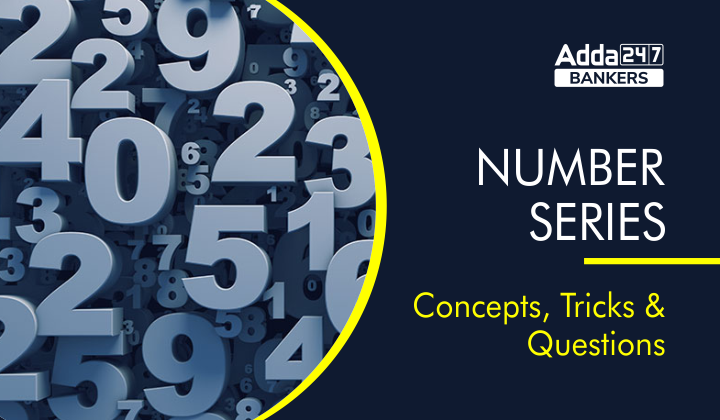Table of Contents
Number Series: Number Series is one of the most crucial topics for competitive exams because 4 – 5 questions are asked from this particular section only. Series is part of both the Reasoning ability and Quantitative Aptitude Sections in a banking exam. It is one of the most important topics in banking, insurance & other competitive exams IBPS Clerk, PO, IBPS RRB PO, Clerk, SBI PO, Clerk, RBI Assistant, LIC AAO, LIC Assistant, etc. Candidates who are preparing for any examination if they know different types and patterns of number series in reasoning as well as quantitative aptitude can easily get 4-5 marks in just 2-3 minutes. In this article, we covered the Number Series in detail.
What is Number Series in Reasoning?
Number series is a sequence formed out of numbers, letters, or words that are obtained by some particular previously defined rule. Number Series aptitude questions present mathematical sequences that follow a logical rule, based on elementary arithmetic. In this question, a sequence of numbers called terms is presented with 1 or more missing elements. These questions are based on the numerical sequences that follow logical rules or pattern-based elementary arithmetic concepts. A particular series is given from which the pattern must be analyzed. Then asked to predict the next number in the sequence following the same rule.
Types of Number Series
There are many types of number series. Some of them are given below. Candidates can check the types of number series in the given table.
| Types of Number Series | |
| Arranging Number Series | Square-based Series |
| Mix Operators Series | Alphanumeric Series |
| Alternating Series | Division Based Series |
| Alphabetical Series | Subtraction Series |
| Fibonacci Series | Symbol Based Series |
| Club Based Series | |
Number Series Reasoning: Concept & Tricks
We have provided some tips and tricks & concepts these tricks & trips are general in nature and candidates can always combine them with their own solving method. let’s take a look at the number series tips & tricks.
- For solving arrangement-based number series in reasoning, candidates need to rearrange the given series by using various processes to find the correct answer.
- Aspirants need to find the logic involved in the given series such as addition, multiplication, alphanumeric
Number Series Reasoning: Question & Answer
Directions (1-5): Study the following digit-letter-symbol sequence carefully and answer the questions given below:
C % B K 1 & A W 5 P E 4 Q @ 7 F 6 G © Z J L 2 € D ¥ M # 8
Q1. How many such symbols are there in the above sequence, each of which is immediately preceded by a consonant and immediately followed by a number?
(a) None
(b) One
(c) Two
(d) Four
(e) None of these
Q2. Which of the following is the fifth to the left of the 15th element from the left?
(a) S
(b) P
(c) E
(d) #
(e) None of these
Q3. If all the numbers are dropped in the given series, then which element will be at the sixth position from the right end?
(a) Z
(b) M
(c) L
(d) D
(e) None of these
Q4. How many such numbers are there in the above sequence, each of which is immediately preceded by a vowel and immediately followed by a consonant?
(a) Three
(b) Two
(c) None
(d) One
(e) None of these
Q5. What should come in place of the question mark in the following on the basis of the above sequence?
B, &, P, 7, ?
(a) #
(b) M
(c) D
(d) 2
(e) J
Direction (6-10): Study the following alphanumeric series carefully and answer the questions given below:
S * 7 B $ © G 2 8 U 1 & A V # F 3 5 H @ 5 Y 5 M 3 2 D 8 % N 2 4
Q6. How many such numbers are there which is preceded by alphabets and followed by symbols?
(a) One
(b) Two
(c) Three
(d) Four
(e) None
Q7. Which of the following elements is 19th from the right end of the series?
(a) #
(b) F
(c) 3
(d) V
(e) None of these
Q8. How many such symbols are there which are preceded by numbers and followed by vowels?
(a) Two
(b) None
(c) One
(d) Four
(e) Three
Q9.How many such alphabets are there which is preceded and followed by the same number?
(a) Three
(b) Two
(c) One
(d) Four
(e) None
Q10. If all numbers are eliminated from the series then, which of the following elements is 11th from the right end of the series?
(a) V
(b) A
(c) &
(d) #
(e) None of these
Directions (11-15): Read the following character sequence carefully and then answer the question given below it.
4 B @ # P W 3 $ 5 % T & 7 8 C F E * © A K 2 U D + ¥ R
Q11. How many such symbols are there in the above sequence, each of which is immediately preceded by a vowel and immediately followed by a symbol?
(a) One
(b) Two
(c) Three
(d) None
(e) None of these
Q12. If all the symbols are dropped in the given series, then which element will be at the 12th position from the left end?
(a) 8
(b) T
(c) 5
(d) E
(e) F
Q13. Which of the following elements is 6th to the right of the 13th element from the left?
(a) ©
(b) T
(c) A
(d) K
(e) None of these
Q14. How many such numbers are there in the above sequence, each of which is immediately preceded by a number and immediately followed by a symbol?
(a) One
(b) Two
(c) Three
(d) None
(e) More than Three
Q15. What will come in place of the question mark of the series?
BP@ $T5 8EC ?
(a) U D +
(b) AUK
(c) © A K
(d) AD2
(e) None of these
Solutions
S1. Ans. (c) (Sol. Q@7, M#8)
S2.Ans. (b)
S3. Ans. (c)
S4. Ans. (d) (Sol. E4Q)
S5. Ans. (e)
S6. Ans (b) (Sol. U1&, D8%)
S7. Ans(d)
S8. Ans(c) (Sol. 1&A)
S9. Ans(c) (Sol. 5 Y 5)
S10.Ans(b)
S11. Ans. (a) (Sol. E * ©)
S12. Ans. (d)
S13. Ans. (a)
S14. Ans. (d)
S15. Ans. (b)
What is Number Series in Quantitative Aptitude?
Number Series is one of the most important topics in Quantitative Aptitude and this is common in any competitive exam. A number Series is defined as a series in which a sequence or a pattern is given. Number Series is a sequence formed out of numbers. You need to find the logical pattern and answer the question accordingly.
Types Of Number Series in Quantitative Aptitude
Number Series is part of almost every exam, where quantitative aptitude is mandatory. Questions related to the number series are being asked for 4 to 5 marks in banking exams. Here we will be going to discuss types of number series in quantitative aptitude. The level of difficulty may vary in each exam. It becomes necessary to be very handy on this topic to ace this part of the quantitative aptitude section.
Based On the Missing Number Series
A missing number series is a particular series in which a specific pattern is being followed by the numbers given in the series and there is one number missing in the series and it is to be found by following the given pattern.
Based On Division And Multiplication
In these types of number series, the difference obtained is the multiplication or division of a specified pattern and among them, there is a wrong number among the given series or the missing number in the series.
Based on the Mix Pattern Series
In mix type number series, the difference obtained is followed by more than two patterns and among them, a given number is wrong and does not follow the specified pattern.
Based on Square And Cube
Based on Differences Series
Tips, Tricks & Concepts To Solve Number Series Questions
- Firstly in number series questions, candidates need to check whether the series has two different operations, which are being alternately performed, or there is a mix of two series.
- A series based on squares is most of the time based on the perfect squares of the number in a specific order and generally one of the numbers is missing in this type of question candidates have to find out this missing number and answer the question.
- A proper series of numbers creates a wrong pattern. In the wrong number series problems, we must identify the wrong pattern of numbers that will lead us to the wrong term in the series. Identity this wrong number.
- In some number series either in ascending order or descending order of numbers each successive number is obtained by dividing or multiplying the previous number by a specific number.
- Learn the squares of all the natural numbers from 1 to 25 and learn the cubes of all the natural numbers from 1 to 25. Check the sequence by analyzing the series by checking the difference, by checking multiples by, dividing, etc between the consecutive terms.
Number Series: Quantitative Aptitude Questions, Answers, & Explanation
Direction (1 – 8): What will come in the place of the question (?) mark in the following number series?
Q1. 36, 48, 62, 78, ?, 116
(a) 96
(b) 98
(c) 94
(d) 92
(e) 102
S1. Ans(a)
The pattern of series –
36 + 12 = 48
48 + 14 = 62
62 + 16 = 78
? = 78 + 18 = 96
96 + 20 = 116
Q2. 12, 8, 12, 24, 56, ?
(a) 142
(b) 156
(c) 144
(d) 150
(e) 148
S2. Ans (d)
Pattern of series –
12 ×0.5+2=8
8 ×1+4=12
12 ×1.5+6=24
24 2 + 8 = 56
? = 56 ×2.5+10=150
Q3. 123, 483, 771, 995, ?, 1283
(a) 1165
(b) 1167
(c) 1143
(d) 1169
(e) 1163
S3. Ans (e)
Patter of series –
123 + (192 – 1) = 483
483 + (172 – 1) = 771
771 + (152 – 1) = 995
? = 995 + (132 – 1) = 1163
1163 + (112 – 1) = 1283
Q4. 147, ?, 246, 345, 477, 642
(a) 180
(b) 178
(c) 184
(d) 196
(e) 190
S4. Ans(a)
Patter of series –
? =147 + (33 ×1)=180
180 + (33 ×2)= 246
246 + (33 ×3)= 345
345 + (33 ×4)= 477
477 + (33 ×5)=642
Q5. 255, 323, 399, 483, ?, 675
(a) 728
(b) 440
(c) 575
(d) 568
(e) 624
S5. Ans (c)
Pattern of series –
255 = (162 –1)
323= (182 –1)
399 = (202 –1)
483 = (222 –1)
? = (242 –1) = 575
675 = (262 –1)
Or
255+ 68 =323
323+ 76(68+8) = 399
399+ 84(76+8) =483
483+ 92(84+8) =575
575+100(92+8)= 675
Q6. ?, 10, 20, 45, 110, 300
(a) 2
(b) 5
(c) 10
(d) 2.5
(e) 7.5
S6. Ans.(c)
Sol. Pattern of series –
![]()
Q7. 25, 90, ?, 177, 203, 220
(a) 150
(b) 148
(c) 144
(d) 140
(e) 160
S7. Ans.(d)
Sol. Pattern of series –
25 + 8² + 1 = 90
90+72+1=140
140 + 6² + 1 = 177
177 + 5² + 1 = 203
203 + 4² + 1 = 220
Q8. 103, ?, 190, 247, 313, 388
(a) 132
(b) 122
(c) 152
(d) 162
(e) 142
S8. Ans.(e)
Sol. Pattern of series –

Direction (9 – 15): Find the wrong number in following number series:
Q9. 1, 2, 10, 37, 100, 226
(a) 1
(b) 37
(c) 226
(d) 100
(e) 2
S9. Ans(d)
Pattern is
1+13=2
2+23=10
10+33=37
37+43=101
101+53=226
So, wrong number = 100
Q10. 15, 75, 129, 191, 243, 309, 357
(a) 15
(b)75
(c) 309
(d) 243
(e) 357
S10. Ans.(c)
Sol.
Wrong term = 309
Pattern of series

So, there should be 307 in the place of 309.
Q11. 8, 20, 56, 116, 200, 320
(a) 20
(b) 200
(c) 56
(d) 116
(e) 320
S11. Ans.(e)
Sol. The given pattern is :
8 + 1 × 12 = 20
20 + 3 × 12 = 56
56 + 5 × 12 = 116
116 + 7 × 12 = 200
200 + 9 × 12 = 308
So, Wrong Number = 320
Q12. 48, 144, 360, 720, 1040, 1080, 540
(a) 1040
(b) 144
(c) 48
(d) 720
(e) 540
S12. Ans(a)
Wrong term = 1040
Pattern of series –
48 ×3=144
144 ×2.5=360
360 ×2=720
720 ×1.5=1080
1080 ×1=1080
1080 ×0.5=540
So, there should be 1080 in the place of 1040.
Q13. 14, 8, 14, 38, 140, 621.5
(a) 38
(b) 140
(c) 621.5
(d) 8
(e) 14
S13. Ans. (b)
Sol. Pattern of series –

So, Wrong Number = 140
Q14. 91, 235, 163, 199, 181, 190, 187.5
(a) 91
(b) 235
(c) 163
(d) 187.5
(e) 199
S14. Ans(d)
Wrong number = 187.5
Pattern of series –
91 + 144 = 235
235 – 72 = 163
163 + 36 = 199
199 – 18 = 181
181 + 9 = 190
190 – 4.5 = 185.5
So, 185.5 should be come in the place of 187.5
Q15. 380, 385, 393, 407, 433, 486, 581
(a) 380
(b) 385
(c) 393
(d) 486
(e) 407
S15. Ans(d)
Sol.

So, 483 should come in the place of 486.
| Related Posts | |
| IBPS RRB PO Syllabus | IBPS RRB Clerk Syllabus |
| RBI Grade B Syllabus | SBI PO Syllabus |
| IBPS PO Syllabus | IBPS Clerk Syllabus |





 GA Capsule for SBI Clerk Mains 2025, Dow...
GA Capsule for SBI Clerk Mains 2025, Dow...
 The Hindu Review October 2022: Download ...
The Hindu Review October 2022: Download ...
 World Malaria Day 2025
World Malaria Day 2025



